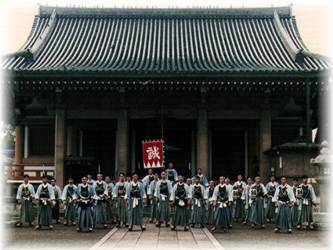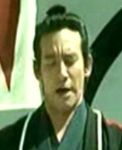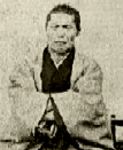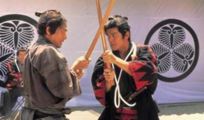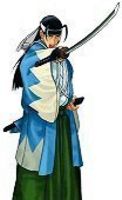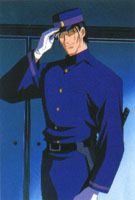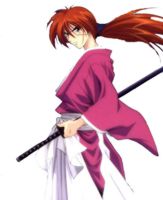 |
T
H E-----R E A L-----L
A S T-----S
A M U R A I |
| WARNING : EVERY PICTURE IS CLICKABLE |
|
The
multiracial Shinsengumists in 2005 |
The
Shinsengumi leaders in 1867 -- |
|
|
History of real-life samurai ended with the diehard supporters of the descendants of the Minamoto clan (click here for story & pictures). The Shinsengumi of Kyoto was one heck of a bunch. They consisted of masterless swordsmen ('ronin' in Japanese) recruited via the hardest tests of their lives -- an audition often meant the end of such lives, mind you -- with the purpose of actively protecting the interests, persons, and properties of the Tokugawa shogunate. The said shogunate did need such a drastic measure; Tokugawa Iemochi and his successor Yoshinobu were among the weakest Shoguns ever, several lightyears away as a far cry from the clan's Ieyasu of 1600's (click here for story & pictures of the Tokugawa shogunate).
Nicknamed 'the Wolves of Mibu', the men of Shinsengumi literally hunted in packs for Emperor Meiji's supporters (click here for story & pictures) -- including their former comrades, since some of the 'wolves' (Ito, Okubo, and so on) jilted them to establish another pack under the Emperor's banner. The Emperor won the bloody power-struggle in 1868, and after the Toba-Fushimi battle, there virtually was no more olden-days-samurai left roaming around the country. Wearing a sword in public was outlawed; this led to countless unnecessary skirmishes and deadly brawls, especially between the cops -- such a thing was entirely new in Japan -- and the proud descendants of the warrior-class of the old regime. Only after years of civil wars (it was plural because each clan seems to have found it better to fight their own), after so many deaths among those who resisted the new order of things, Emperor Meiji's Japan came to lay its foundations of a nation-state firmly for good. In the last battles of the Tokugawa supporters, the Shinsengumi was virtually all gone, though a few of its members survived (click here for real war of Shinsengumi versus Meiji supporters).
But the 'Wolves', in real life, never die. Even this very minute of 21st-century Shinsengumi has too many admirers around the world; names of its faithful members such as Hijikata, Kondo, Okita, Nagakura, and so on have been household names even in Indonesia, South Africa, Germany and the USA; the former Kyotoite HQ of the Wolves has been an international tourist attraction (most of whose visitors take it as a pilgrimage). So Shinsengumi is, by the time you waste your precious time to read this, one of the border-crossing pop cults on this sorry little planet earth. Since 1994, hundreds of local American Shinsengumist clubs have been springing up like vodka in a Muscovite winter. On this Planet Pop, nobody seems to remember that the real-life and original and Japanese Shinsengumi of Kondo's and saito's and Okita's et.al., collectively and individually alike, would have loved to whack caucasians apart any minute of the day. Especially Americans. Much of what went on in Japan during this Meiji confusion of 1868 was a heavymetal attitude of being anti-foreigners. Or else the bombings of Lord Saigo's beautiful samurai city Kagoshima by the American and British battleships, the assault toward the American Consulate by local samurai, the killings of British reps by another bunch of samurai, and so on, wouldn't have made any sense. (Click here for the Meijian view of it, or click here to continue real history of the Shinsengumi.) It also makes no difference whatsoever even as politically-correct historians keep on telling these Shinsengumists that the Shinsengumi of 1800's was a group of ruthless urban omnivores, whose method was to storm into a private room, a public inn, or a cul de sac and first of all overwhelm the intended targets by sheer number. What the rest of the globe knows about Japanese swordsmanship is that samurai don't fight in flocks; honor means a one-on-one swordsplay, and so forth; this has been hurting the image of Shinsengumi outside Japan (even inside there, so some said). One of the best contemporary comic book artists of Japan, 1970-born Watsuki Nobuhiro, even has to make his leading character Himura Kenshin in the series bearing that name (you might have known his major work as Samurai X if you're not Japanese) to say this for the sake of fairplay:
Watsuki's Himura is an assassin on Meiji government's payroll -- so this is supposed to mean something. And of course no one recalls the very factual thing that the Shinsengumi killed and get killed for the wrong side of Japanese politix. They upheld a crumbling political regime that had neither legitimacy, real power, statesmanship, leadership, or at least cash. The Tokugawa shogunate at the time the real Shinsengumi was actively hunting people down was one heck of a pain in the neck, led by Shoguns that would never even got themselves elected to be supervisors in a small-time Japanese factory. Their reign was so inefficient that the Meiji Government later had to overhaul everything back from scratch. 'Samurai' is a fixed notion. You can't just twist and warp it to suit unrelated occasions. And to a samurai -- which must be a Japanese, being a samurai itself is equal to being Japanese, and don't forget that the core of Shinto and Buddhist faiths is an extension of filial piety towards your superiors -- fighting against the Emperor is the ultimate sociopolitical sin that you could possibly commit. A Shogun was just a vassal (i.e. subordinate, a.k.a underling, alias those who must submit to the authority) of any Emperor, no matter how many cannons the Shogun owned. Once you take the Shogun as the ultimate authority in Japan, and unsheath your sword against the real source of mandate -- the Emperor -- you are a disgrace to the entire samuraihood (click here for the Japanese powergame since time immemmorial, and what it meant to be a Shogun, to begin with). Once you are against the Emperor, you are an enemy of the State. And that was against Shinto, against Buddhism, against the essence of being Japanese, against Life itself. There you are. It's a truly scary thing. That's why the real-life and original Shinsengumi fought like mad against the armies of Emperor Meiji's warlords, such as the Mori clan of Western Japan (click here for history and pictures of the clan), but their commander in the battle, Hijikata Toshizo, pulled his comrades back when it was clear the Moris and such fought under the Imperial banner (click here if you have no idea what I'm talking about). However, in 21st century it seems like everybody has downloaded a collective amnesia when it comes to the subject of why and what for the real Shinsengumi existed at all. That surely is the most convenient amnesia, and it sustains the popularity of the historically-warped portrait of the Shinsengumi (click here for what other persistent errors are there about the original Shinsengumi).
For this undying fame Shinsengumi only owes itself; they are a ripe and ready-for-use material for fiction-weaving. They got a clear purpose to serve, they had boldly-scribbled faith (see that red banner with the word 'Loyalty' on it -- click here for the true meaning of the word, which is not what you think it is), they were mostly young and could easily be digitally beautified to seem good-looking somewhat, and (this is the best material of all) they had a uniform. Oh, yes. A uniform is essential to the propagation of a cult. The Shinsengumi's signature headgear, for instance, would have been enough to generate a cult of fans; it's predictably a blast around fandomism as we know that they got a lot more than that.
For a visual treat of metal fangs and claws of this group, see Takita Yojiro's movie When the Last Sword is Drawn (Mibu Gishiden, 2004), starring Nakai Kiichi as Yoshimura and Sato Koichi as Saito. An anime has taken the 'Mibu Wolves' as its central characters, too: check out Peacemaker Kurogane (2004). Watsuki Nobuhiro's comic books (started in 1994) that got animated since 1996 onward by directors Furuhashi Kazuhiro and Tsuji Hatsuki, Rurouni Kenshin (Samurai X), covers the same period of history; it features the Shinsengumi. The leading character Himura Kenshin -- nicknamed 'The Master Slayer' ('Hitokiri Battosai') is a pro-Meiji swordsman ('Isshin samurai' in Japanese). This character is based on the real-life swordsman, traditionally assumed to be one of the best in his art, Kawakami Gensai (1834-1871). Started out as an assassin for the Meiji administration, Kawakami was framed and given a death-sentence when he was seen as outliving his usefulness for the new regime. There were abundant tales like this concerning real people of the era; a revolution always devours its own kids like the cliche says. Himura Kenshin's buddy Sanosuke Sagara was based on the life of a real person, too, the famous Satsuma streetfighter Sano Takenosuke. Click here to see what the anime movie is like.
|
|||||||||||||||||||||||||||
